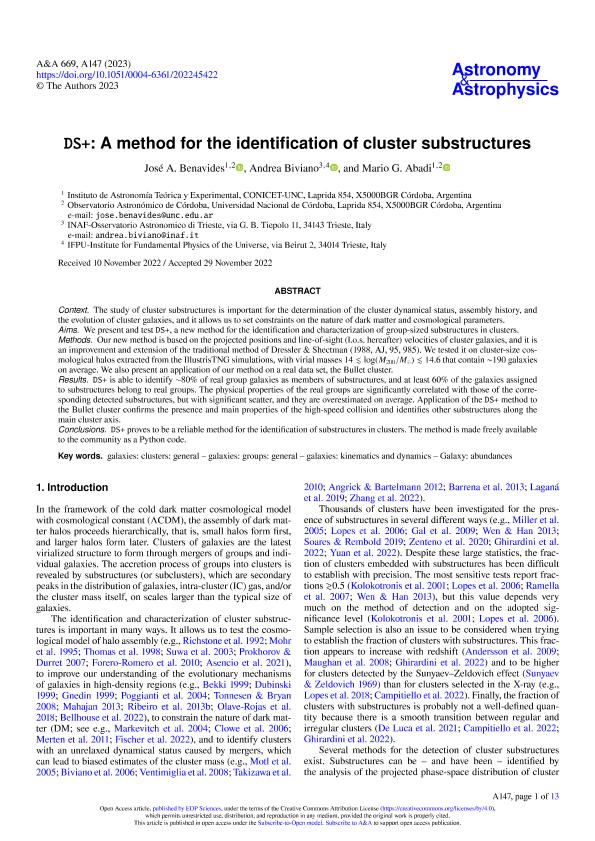Mostrar el registro sencillo del ítem
dc.contributor.author
Benavides Blanco, Jose Antonio

dc.contributor.author
Biviano, Andrea
dc.contributor.author
Abadi, Mario Gabriel

dc.date.available
2024-02-06T15:01:31Z
dc.date.issued
2023-01
dc.identifier.citation
Benavides Blanco, Jose Antonio; Biviano, Andrea; Abadi, Mario Gabriel; DS+: A method for the identification of cluster substructures; EDP Sciences; Astronomy and Astrophysics; 669; 1-2023; 1-13
dc.identifier.issn
0004-6361
dc.identifier.uri
http://hdl.handle.net/11336/225987
dc.description.abstract
Context. The study of cluster substructures is important for the determination of the cluster dynamical status, assembly history, and the evolution of cluster galaxies, and it allows us to set constraints on the nature of dark matter and cosmological parameters. Aims. We present and test DS+, a new method for the identification and characterization of group-sized substructures in clusters. Methods. Our new method is based on the projected positions and line-of-sight (l.o.s. hereafter) velocities of cluster galaxies, and it is an improvement and extension of the traditional method of Dressler & Shectman (1988, AJ, 95, 985). We tested it on cluster-size cosmological halos extracted from the IllustrisTNG simulations, with virial masses 14 ≲ log(M200/M· ) ≲ 14.6 that contain ∼190 galaxies on average. We also present an application of our method on a real data set, the Bullet cluster. Results. DS+ is able to identify ∼80% of real group galaxies as members of substructures, and at least 60% of the galaxies assigned to substructures belong to real groups. The physical properties of the real groups are significantly correlated with those of the corresponding detected substructures, but with significant scatter, and they are overestimated on average. Application of the DS+ method to the Bullet cluster confirms the presence and main properties of the high-speed collision and identifies other substructures along the main cluster axis. Conclusions. DS+ proves to be a reliable method for the identification of substructures in clusters. The method is made freely available to the community as a Python code.
dc.format
application/pdf
dc.language.iso
eng
dc.publisher
EDP Sciences

dc.rights
info:eu-repo/semantics/openAccess
dc.rights.uri
https://creativecommons.org/licenses/by-nc-sa/2.5/ar/
dc.subject
GALAXIES: CLUSTERS: GENERAL
dc.subject
GALAXIES: GROUPS: GENERAL
dc.subject
GALAXIES: KINEMATICS AND DYNAMICS
dc.subject
GALAXY: ABUNDANCES
dc.subject.classification
Otras Ciencias Naturales y Exactas

dc.subject.classification
Otras Ciencias Naturales y Exactas

dc.subject.classification
CIENCIAS NATURALES Y EXACTAS

dc.title
DS+: A method for the identification of cluster substructures
dc.type
info:eu-repo/semantics/article
dc.type
info:ar-repo/semantics/artículo
dc.type
info:eu-repo/semantics/publishedVersion
dc.date.updated
2024-02-06T13:43:21Z
dc.journal.volume
669
dc.journal.pagination
1-13
dc.journal.pais
Francia

dc.description.fil
Fil: Benavides Blanco, Jose Antonio. Consejo Nacional de Investigaciones Científicas y Técnicas. Centro Científico Tecnológico Conicet - Córdoba. Instituto de Astronomía Teórica y Experimental. Universidad Nacional de Córdoba. Observatorio Astronómico de Córdoba. Instituto de Astronomía Teórica y Experimental; Argentina
dc.description.fil
Fil: Biviano, Andrea. Università degli Studi di Trieste; Italia
dc.description.fil
Fil: Abadi, Mario Gabriel. Consejo Nacional de Investigaciones Científicas y Técnicas. Centro Científico Tecnológico Conicet - Córdoba. Instituto de Astronomía Teórica y Experimental. Universidad Nacional de Córdoba. Observatorio Astronómico de Córdoba. Instituto de Astronomía Teórica y Experimental; Argentina
dc.journal.title
Astronomy and Astrophysics

dc.relation.alternativeid
info:eu-repo/semantics/altIdentifier/doi/http://dx.doi.org/10.1051/0004-6361/202245422
Archivos asociados
